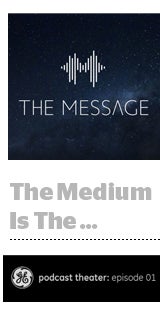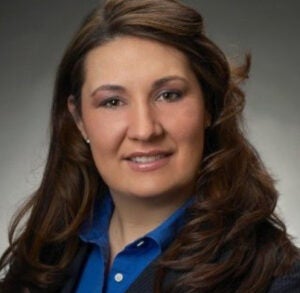 If native advertising is a message designed to mimic the form and function of its environment, then there’s almost nothing out there as native as a podcast.
If native advertising is a message designed to mimic the form and function of its environment, then there’s almost nothing out there as native as a podcast.
As in the early days of radio, hosts often read and personalize an advertiser’s message so that it “feels inclusive, like part of the program,” said Matt Turck, chief revenue officer at Panoply, a podcast network launched by The Slate Group earlier this year that helps interested parties create, distribute and monetize podcasts.
But General Electric is taking an even subtler route with the Oct. 4 release of its podcast, “The Message,” an eight-episode weekly sci-fi drama series that’s “more branded entertainment than branded content,” said Andy Goldberg, GE’s global creative director.
GE worked with creative agency BBDO, The Grid (a custom GE-focused media shop comprised of Giant Spoon and OMD) and Panoply to conceptualize, write, produce and promote the series through social, billboards and cross-promo across Panoply’s network of podcasts, including Huffington Post, Vox, Vanity Fair, Real Simple, Sports Illustrated and, of course, Slate.
“We want to reach tech influencers, young people, people interested in science, potential recruits to teach them what GE is all about,” Goldberg said. “But the question was, how do we do it in a way where we’re not hammering them with advertising messages?”
GE’s answer is “GE Podcast Theater,” featuring an audio narrative that tells the story of Nicky, a wide-eyed podcaster and linguistics buff, who is invited into the inner sanctum of an encryption lab called Cypher to observe as two world-renowned cryptologists work to decode an alien message first received 70 years ago at the close of World War II.
Rather than inserting ads before or within the episodes, GE opted to cleverly weave itself into the actual storyline. At one point in the story, Nicky encounters a GE scientist and ultrasound expert who helps her in her quest to crack the code. And although the story is fictional, much of the science and technology referred to is real and related to projects that GE is actually working on, including experimentation around how sound waves can be used to help heal the human body.
[soundcloud url=”https://api.soundcloud.com/tracks/226449008″ params=”color=ff5500&auto_play=false&hide_related=false&show_comments=true&show_user=true&show_reposts=false” width=”100%” height=”166″ iframe=”true” /]
“The Message” also carries less branding than “General Electric Theater,” a GE-sponsored radio anthology series that ran from July through October 1953. At the beginning of each program, an announcer would intone in a resonant voice, “Presented by the makers of famous, dependable kitchen and home laundry appliances: General Electric” – a promo not at all dissimilar, but somewhat more shilly, to the host-read native ads in podcasts today.
“Podcasting is a bit of a nod to the past, to the old radio shows,” Goldberg said. “Radio shows used to engross people in real, deep narratives and we felt like there was something interesting we could do here considering how podcasts have exploded.”
The otherworldly success of NPR’s ”Serial” is evidence that podcasts have the potential to aggregate highly engaged audiences. The episodes in season one of “Serial” were downloaded more than 68 million times between its launch in October 2014 and February of this year, according to CBS News. A second season is slated for the fall.
Beyond the phenomenon of “Serial”, a study conducted by Edison Research and Triton Digital found that monthly audio podcast consumption increased from around 39 million monthly users in 2014 to 46 million in 2015.
But whereas “Serial” hooked up with email marketing solutions company MailChimp as a sponsor for season one – each program would begin with a charmingly simple 20-second spot that fit into the flow of the show – GE isn’t looking to monetize “The Message.” At least not yet.
“There might be opportunities to do more down the road, but this isn’t really meant to be monetized through other advertisers,” Goldberg said. “For now, it’s another mechanism for us to get out there and reach a different audience in a new way.”
Although it may be eschewing the traditional advertising model, GE is also producing companion content to live alongside the podcast itself, including a blog written by the main character and a real website for the fictional encryption think tank featured in the show.
GE plans to track the number of downloads and subscribers, as well as engagement around the extra blog and website content, although there isn’t a specific number it’s shooting for. If listeners seem to enjoy the experience, GE will invest in creating more programs for “GE Podcast Theater.”
For podcasts that work do with advertisers, however, it makes sense for the sponsored message to be as authentic as possible and contextual to the content of the show. Companies like Midroll Media, for example, act as intermediary reps, pairing sponsors with podcasts and selling native ads into shows like “WTF With Marc Maron,” “Epic Rap Battles of History,” “Savage Lovecast” and “Grammar Girl.”
As Yahoo CEO Marissa Mayer noted at IAB MIXX during Advertising Week in New York City on Monday, “The more the advertising and sponsored messages are like the content around it, the more of a reason you are giving users to not turn that off because it’s actually very content rich.”
But while podcasting gives advertisers access to an “uncluttered” channel in a “cluttered advertising world,” as Panoply’s Turck put it, frequency capping is the key to keeping it that way. Panoply only allows the podcasts in its network to include one to three ads per show, depending on the program’s length.
While ad blocking was far from Goldberg’s mind when GE started developing script treatments for “The Message” with Panoply, it’s not a leap to see the program as one possible example of an ad-blocking antidote – the type of content that people actively seek out rather than actively shun.
But that takes work, Goldberg said.
“Content is not a commodity that you just throw out there – it takes investment in good storytelling and good creative,” said Goldberg. “But it’s entirely possible for something like a 30-second ad to be quality entertainment, too, something people choose to look at. In a sense, ad blocking is just blocking junk.”
“The Message” will be available as a free download on iTunes, Spotify, Stitcher, Soundcloud, Overcast and TuneIn starting Oct. 4.














